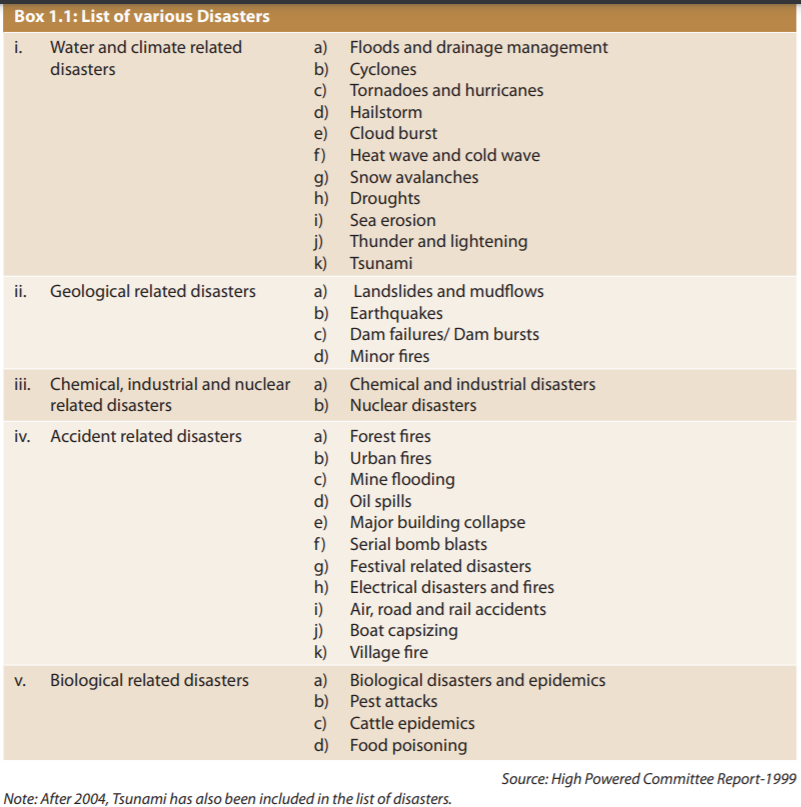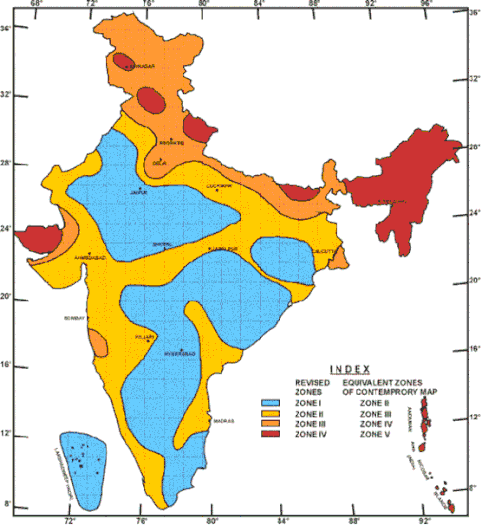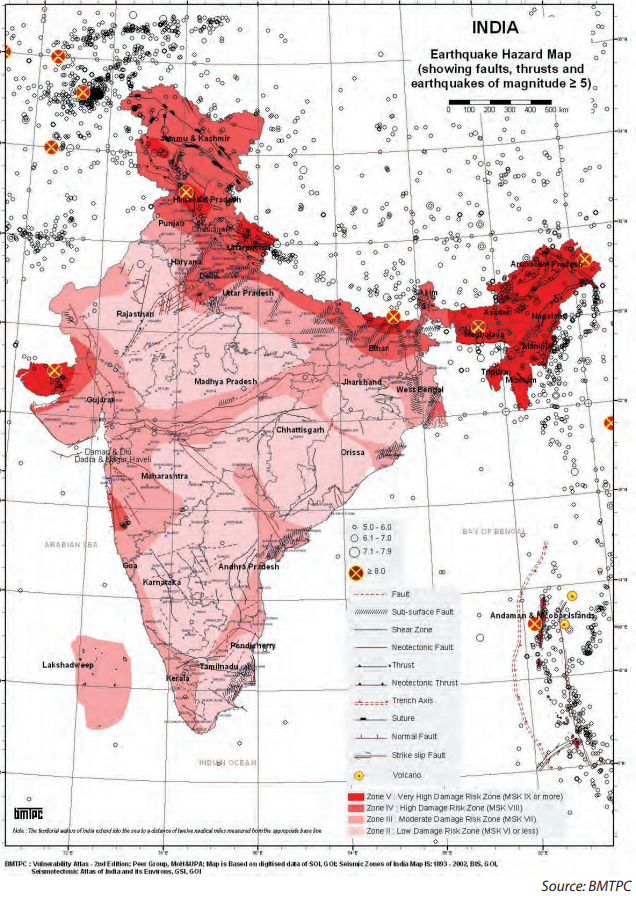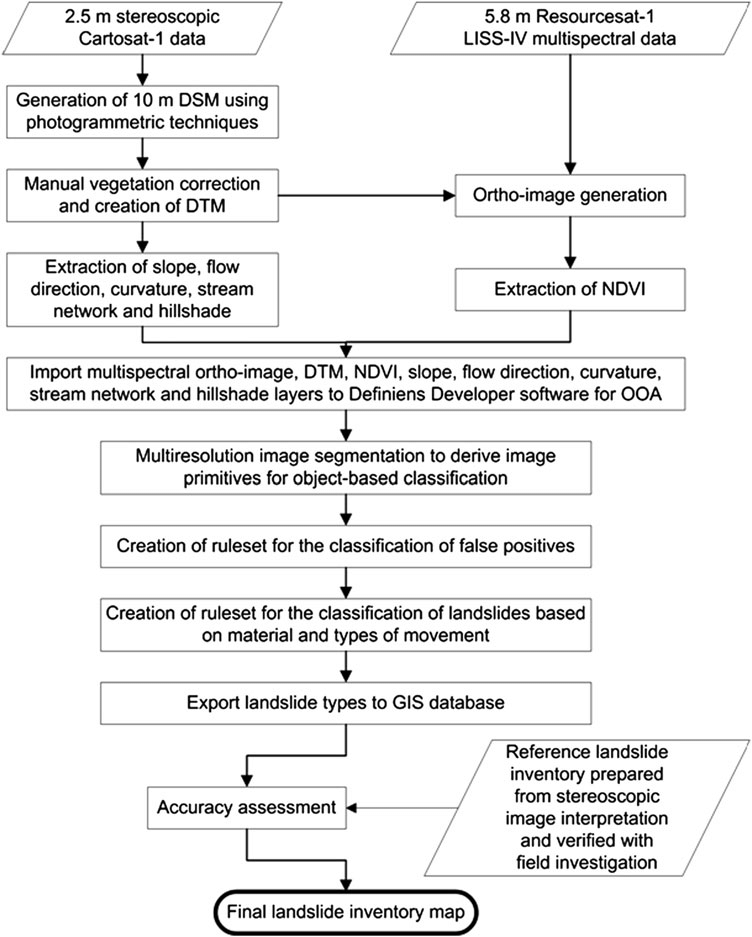Classification of Disasters by Government of India

Disasters in India
Earthquake
Earthquake is a sudden release of energy with series of underground shock waves and movements on the earth surface caused by natural processes because of the movement of tectonic plates.

Elements at Risk
- Location of settlements at earthquake prone area especially on soft ground, or area prone to landslides or along fault lines.
- Dense collection of weak building with high occupancy.
- Non engineered buildings constructed, buildings with heavy roof, poor quality and maintenance
Typical Effects
- Loss of buildings, landslides, fires, etc
- Causalities often high near to epicenter and in places where density of population is high.
- Public health, multiple fracture injuries.
- Breakdown in sanitary conditions may lead to epidemics.
- Water Supply, Transport Networks, Electricity and Communications.
Main Mitigation Strategy
- Engineered Structures to withstand ground shaking. The soil type of the land where the construction is to be done should be analyzed so as to avoid building structures on soft soil.
- Strengthening of important lifeline buildings which need to be functional after disaster.
- Public awareness, sensitization and training programs for architects, builders, contractors, engineers.
- Reducing possible damages from secondary effects.

Community Based Mitigation
- Earthquake drills
- Community based earthquake risk management
Steps by Indian Government
- National Earthquake Risk Mitigation Project : The project aims at strengthening the structural and non structural earthquake mitigation efforts and reducing the vulnerability in high risk districts prone to earthquake.
- National Building Code : Salient features of NBC 2005 include meeting the challenges posed by natural calamities and reflecting the state of art and contemporary applicable international practices
- Initiative by Ministry of Panchayati Raj : It releases fund under Backward Region Grant Fund for meeting critical infrastructural gaps and other developmental requirements. The Ministry in 2010, advised all the states that it is imperative for all such structures to be made disaster resilient in line with national vision of disaster management.
Post Disaster Preventive Measures
- Maintenance of Law and order, prevention of looting, etc.
- Evacuation of people, decontamination.
- Maintaining supplies of essential services
- Quick assessment of destruction and demarcation of affected areas.
- Quick financial assessment of losses.
Tsunami
Tsunami is a Japanese word for “Harbor Wave”. These waves, which often effect distinct shores originates from under sea activity. The sea water is displaced with violent motion, swells up, ultimately destructing the land with power.
Tsunami Warnings
Tsunami is not a single wave, it consists of more than 10 waves which is termed as “Tsunami Train waves”. Since earthquakes can’t be predicted, Tsunami also can’t be predicted. The warning can be made, whose time depends on distance of epicenter from the coastline.
Elements at Risk
- Settlements within 200m of low lying shore area.
- Floods in adjacent areas.
- Structures of wood, mud and without proper anchorage.
- Infrastructure facilities like ports and harbors, etc
Typical Effects
- Physical damage
- Environmental and Infrastructure damage
- Causalities and Public health
- Standing crop and food supplies
- Water supply
Preparedness Measures
- Hazard mapping
- Early warning systems
- Community Preparedness, especially ones living of coastline
Main Mitigation strategies
- Site planning and Land management : Within the broader framework of comprehensive plan, site planning determines the location, confederation, density of population on certain sites and is therefore and important tool in reducing risk
- Engineering Structures
- Avoid building within 100ft of coastline
- Constructing a structure on higher ground level with respect to Mean Sea level
- Construction of water breakers to reduce velocity of waves.
- Flood Management
Tsunami Sources for India
- Sumatra Region
- Makran Region of Pakistan
Structural Measures
- Plantation of Mangroves and Social forests along coastline
- Construction of location specific seawalls and coral reefs on consultation with experts.
- Development of breakwaters along the coast
- Development of bioshield (narrow strip of land running parallel to coastline)
- Identification of vulnerable structures and appropriate retro fitting for Tsunami resistance for all such buildings as well as appropriate planning and designing of new facilities
Non Structural Measures
- Strict implementation of Coastal Zone Regulations
- Mapping coastal areas for multiple hazards.
- Capacity building requirements for local people and administration.
- Developing tools and techniques for vulnerable areas
- Awareness generation and training among fisherman, coast guards, port authorities, etc. for post Tsunami activities.
Tsunami Warning and Communication System
It has been established in INCIOS, Hyderabad. It has the responsibility to provide Tsunami advisories to Indian mainland and island regions.
Landslides
Landslides are slippery masses of rock, earth or debris which move by force of their own weight on mountain slopes or river banks.
Types of Landslides
- Debris flow
- Soliflucation
- Soil creep
- Mud flow
- Rock flow
- Block slide
Causes of Landslides
- Geological Weak material : Weathered Materials, Jointed or Fissured materials, Permeability
- Erosion : Wave, glacial, fluvial erosion of the slope toe
- Deforestation or vegetation removal
- Intense Rainfall
- Human excavations
- Human excavation of slope and its toe
- Mining
- Deforestation
- Water leakage from services
- Earthquake shaking : This has triggered landslides in different topographic and geologic settings. Rockfalls from steep slopes involving thin or shallow disaggregated soils
- Volcanic Eruption
Landslides in India
The Hazard zones include the complete Himalayan belt, Western ghats, a part of Vindyan Range. Human intervention by way of slope modification has in fact caused landslides in more stable landscapes or Western ghats and Nilgiris.
Hazard Zonation
It is divided into 4 zones
- Severe to High : Areas well known for danger of landslides and perennial threat to life and property. Restriction of all new construction, improved land use practices should be encouraged.
- High : Landslides occurred in past and expected in future
- Moderate to Low : Engineered and well regulated new construction activities and well planned agricultural practices would be permitted.
- Unlikely : No visible sign of slope instability in present stage of knowledge

Mitigation Strategies
- Locating areas prone to slope failures
- Retaining walls can be built to stop land from slipping. It is constructed to prevent smaller and secondary landslides that often occur along the toe of larger landslides
- Surface drainage control works are implemented to control the movement of the landslides accompanied by infiltration of rain water and spring flows.
- Engineered structures with strong foundation can withstand and take ground movement forces
- Increasing vegetation cover
- Insuring the individuals will assist them whose homes are likely to be damaged by landslides or by any other hazard.
- Land use practices need to be taken such as
- Areas covered by degraded natural slopes in upper slopes need to be afforested
- Any developmental activity should be taken up after detailed study of area and slow
- In construction of roads, canals, etc proper care is to be taken to avoid blockage of natural drainage
- Total avoidance of settlements and relocating the settlements in risk zones should be made mandatory.
- No construction of buildings in areas beyond a certain degree of slope
Community Based Mitigation Strategies
Communities can play a vital role in identifying the areas where there is land instability. Compacting ground locally, slope stabilization and avoiding construction of houses are points which community should agree with.
National Landslide Risk Management Strategies

Chemical Disasters
These may occur at any time or process of the chemical industrial process. Release of toxic chemicals can cause irreparable damage to people and environment. Non availability of accident investigation agency and exclusive chemical accident database is con for India. Since BGT 1984, there has been a paradigm shift in government approach to safety in industries from reactive model to proactive model. MoEA is the nodal ministry for this type of disasters.
Ageing of process plants, defects in design and inadequate steps to pace with modern technologies in chemical industry has increased the vulnerability. Majority of accidents occur due to human error. There is increased threat due to terrorist activities and sabotages. Other disasters like floods and earthquakes caused disasters in chemical industries. Other common cause that results in chemical disaster is the improper maintenance of the equipment.
Prevention and Response
- Role of Industry
- Identification of possible hazard by having dedicated team of knowledgeable persons and having identification tools.
- Maintenance of plant facility and equipment.
- Installation of gas detection system.
- Compliance with existing rules and regulations.
- Development of Human resource management.
- Emergency preparedness.
- Role of Government
- Setting up accident investigation board and chemical accident database. Accident Investigation board in similar lines of USA can be setup to investigate chemical disasters.
- Awareness campaign .
- Research and Development.
- Transportation of hazardous chemicals. Recently Indian Chemical Council has initiated a program called Nicer Globe which provides GPS tracking of trucks from origin to destination.
- Role of Community : General awareness of the risk associated with any chemical accident would help in reducing the outcome of the accident. Mutual Aid group can be setup to organize the general public in case of any disaster and provide training and awareness about the potential actions to be taken in case of chemical leakage.
💡 Explain the role of Industry, Government, Public to deal with Chemical disasters in light of NDMA guidelines.
Biological Disasters
These define the devastating effect caused by an enormous spread of a disease, virus or infestations of a plant, animal or insect lies on a epidemic or pandemic levels. Cholera, Influenza, Pink ball worm, Foot and Mouth disease in cattle outbreaks are examples of biological disasters. Epidemic level biological disasters effect large number of people within a community or area whereas pandemic level biological disasters effect a much larger region spanning entire continent or globe. Ministry of Health and Family Welfare is nodal ministry.
Biological Hazards
Refers to biological substances or organic matter produced by parasites, viruses or bacteria, fungi that cause a threat to the health of living organisms primarily that of humans. Biological warfare also known as germ warfare is use of biological toxins or infectious agents with the intent to kill or incapacitate humans. MoHA is nodal ministry for bio warfare and partners with Health ministry. WHO contributes to global health security by
- Strengthening the National Surveillance system
- Disseminating verified information on outbreaks of diseases and also by providing technical support or response.
- Collecting, analyzing and disseminating information on diseases likely to cause epidemics of global importance.
Legislations
- Water (Prevention and Control of Pollution) Act, 1974
- Air (Prevention and Control of Pollution) Act, 1981
- Environment Protection Act, 1986
- Disaster Management Act, 2005
Control
- Elimination of source of contamination is fundamental to the prevention and control of biological hazard
- Engineering controls such as partial isolation of contamination source, use of UV lamps, improvement of ventilation can help contain the spread
- Personal hygiene and Personal protection
- Sterilization, which is a process using heat or high pressure to eliminate bacteria and microorganism to ensure that the employees or population would not be harmed to exposure in the risk area.
Prevention
The important means for prevention of biological disasters include
- Risk assessment
- Environmental Management : Safe water supply and Proper maintenance of sewage
- Necessary awareness should be created
- Vector control programs like elimination of breeding places, spraying of insecticides, keeping watch on rodent population, burial and disposal of dead.